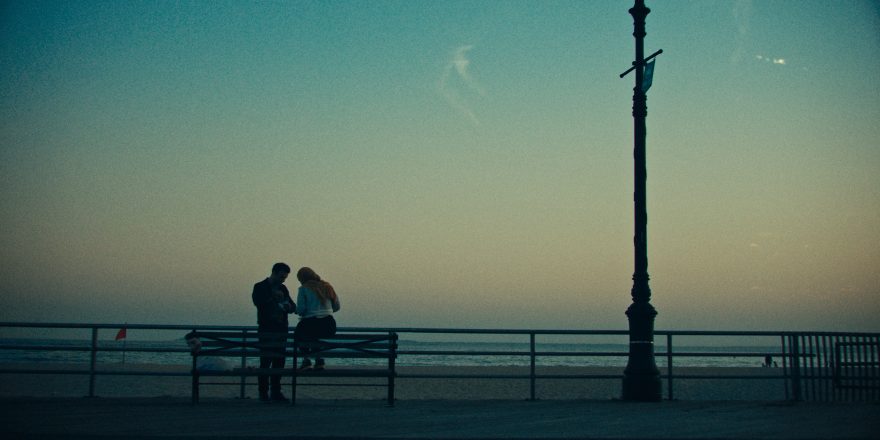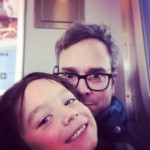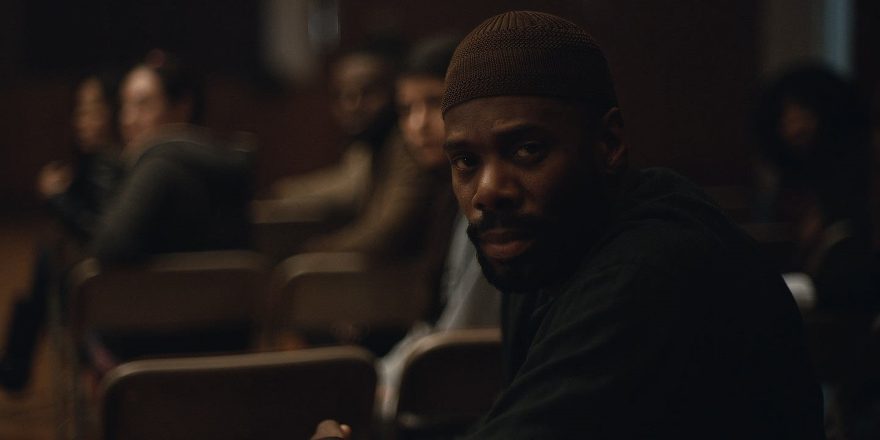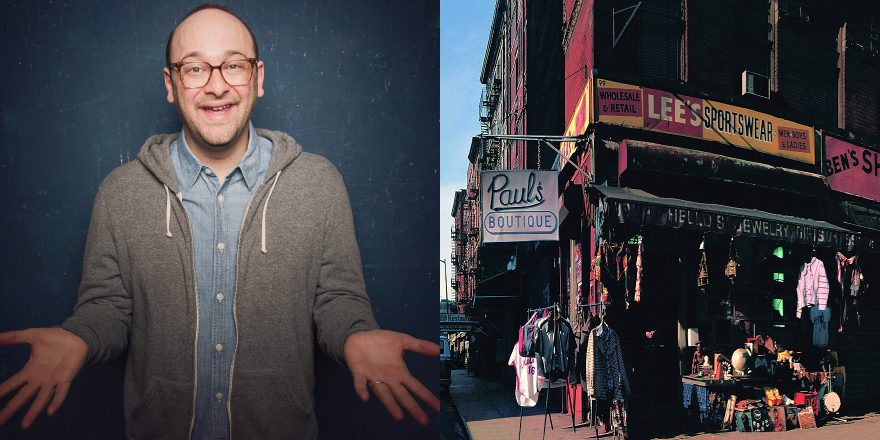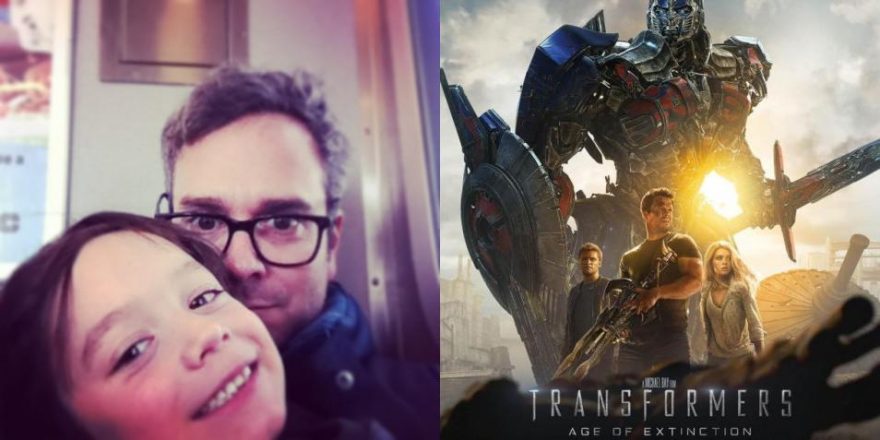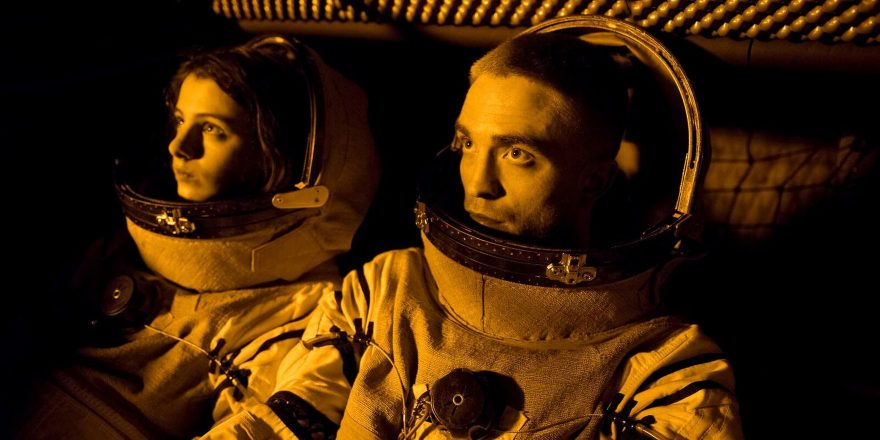The shot I’m thinking about comes near the end of the second act. Our two protagonists, a troubled Coney Islander with a James Dean complex named Saul and a runaway escaping from under the thumb of her guardians named Zama, sit on a bench on a desolate stretch of boardwalk looking out over the ocean. They’re on the run, as they plot revenge on a villainous real-estate developer. But right now, they’re having a snack. The sun has set and the sky is left with the muted blue grades of twilight. They’re in no rush. After a while, he asks if she’d like to try some pickled watermelon. She does.
“Wow… it’s so sour,” she says.
“Sour’s good,” he replies.
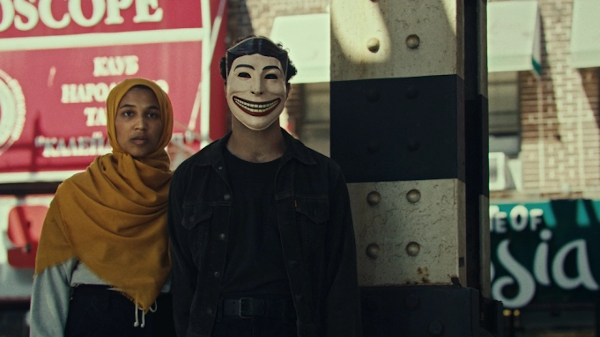
He stuffs a slice of dark rye bread slathered with butter into his mouth and keeps eating. As if we can’t bear to leave such a good vibe, the camera stays and watches as they both look out at the evening horizon. Time goes by. You can hear kids playing down by the water. A red flag flutters on the beach. After a while, she gently puts her head on his shoulder and sighs. From his reaction, you get the sense nobody has ever done that to him before this very moment. He eats another pickle. And he is happy.
This scene is me. Not simply as a filmmaker, but as a New Yorker, and it has somehow become my vision of a perfect post-pandemic city. The visual architecture of the shot borrows heavily from the final image of Antonioni’s L’Avventura, the misfit leads resemble distant cousins to early Jarmusch characters, and the earnest, quiet ambiance wouldn’t be weird showing up in a Mike Mills film. But it’s the pickles and the company and the sense of place that make the scene what it is.

Before Funny Face, I had lived in New York over 20 years without having made a feature film here, seeking out stories in other parts of America where I could observe from a distance. Those films worked (from my view, at least) because they are the unique, empathetic viewpoints of a stranger. But when you film in your backyard, there can’t be distance. You can’t be a stranger. You have to be a participant. And you have to revel in it. Look at Uncut Gems and tell me the Safdie brothers are not fully reveling in the shit. Scorsese in The King of Comedy or After Hours. My tiny film isn’t at the level of those New York-based masterpieces, but the point is I knew that if I was going to make a New York movie, I had to be really true to my New York. And I had to revel in it. So when I decided to do Funny Face, I wanted to both pay homage to the New York genre and make it a love story with lots of food in it.
To find its voice and look, the film borrows from the Ramones, Taxi Driver, Requiem for a Dream, Bad Lieutenant and American Psycho, among others. It is meant to feel gritty or sublime, moment to moment. It howls from a cracked sidewalk about how money, gentrification, economic inequality (and the Knicks sucking) have crushed the city’s once-thriving soul. It’s a clown-masked indie King Kong swinging from the Empire State building as it laments the unleashed Masters of the Universe who have stolen all of the corners away from the bodegas so that they can launder their money in new glass towers. The frustration is an essential part of the story. It is real. But it’s easy to solely concentrate on the rage.
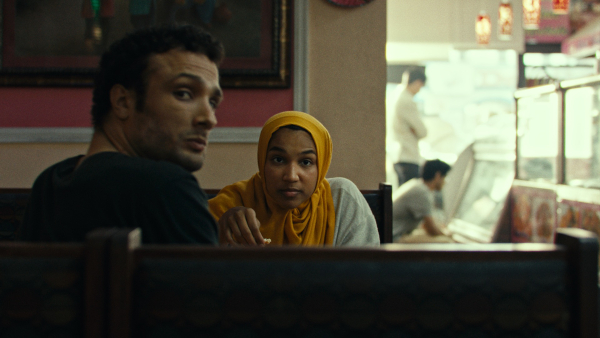
To me, a New York story has to come from extreme ends of the pleasure spectrum (please remember that When Harry Met Sally is, in its own way, a New York movie to the utmost). I wanted to make something that was at odds with itself. As Spike Lee showed in Do the Right Thing, with Hate comes Love (he also stole that from The Night of the Hunter, but whatever). Thus, woven within that anger is a love for this city and what it offers that has always stood as a celebration to me: food.
It isn’t unique to claim that New York is food. Throw a stick and you’ll hit someone who can tell you that the best bánh mì in the city is actually in the back of a jewelry store. That’s my New York. Some years back, I co-founded a dining group made up of a few journalists, filmmakers and teachers that meets regularly to explore the dark arts of the city’s palate. We have more or less eaten everything. In every borough. Through the gluttony, we’ve celebrated New York’s myriad cultures and it’s how I’ve come to find my home in the city. I remember reading somewhere that Jarmusch said he learned more about filmmaking watching a single baseball game with Samuel Fuller than he did in years of film school. So I’ve learned more in the basement of a Malaysian restaurant or around the table of a Bukharan banquet than I did in multiple years of graduate school. I’ve sipped rum that came out of the trunk of a Haitian restaurant proprietor’s car, squeezed lemon over a bed of Turkish calf’s liver fit for gods and inhaled more goat, lamb and their entrails in more Georgian, Henan, Trini, Dongbei, Uyghur and Baltic restaurants than is healthy (apologies to any vegan readers). It has been my New York school.
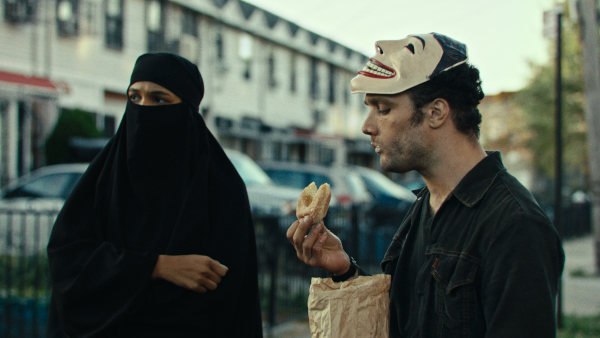
I’m not alone. I met my first distributor, Matt Grady of Factory 25, over mofongo at El Castillo de Jagua, was introduced to the best Uzbek restaurant in the city by filmmaker Eliza Hittman and botched a meeting with an unnamed festival programmer because of a disagreement over a Vietnamese curry (he was wrong). My son Zach and his crew know where the best big tray chicken is (Spicy Village) and when my son Theo walks into the Jamaican spot Fisherman’s Cove, they pretty much know his order. This is how I fell in love with the city. This is how I stay in love with the city. It’s one of the reasons why I could never leave. It’s one of the things that keeps me alive when the utter bullshit and horrible inequities and sheer pain that this place offers looms large. So why would my characters in Funny Face be any different?
Saul is losing his home, his grandparents displaced by the developer of a soulless high-rise. He finds a mask – or maybe the mask finds him – offering him a makeshift transformation into a DIY superhero with vengeance on the brain. Zama runs away from the stifling watch of her aunt and uncle to find herself homeless, the subject of both ethnic and gender discrimination. The only traits they seem to share are that they’re both extremely headstrong and both terribly alone. So, like many authentic New York friendships, it is food that brings them together.
They meet-cute over pistachios – her stealing them, him helping her out – which leads to a mutual curiosity. When they start to get to know each other over donuts, they aren’t just any donuts. They are the type of donuts you walk extra blocks to get because you have a relationship with them. Saul would say they are his donuts. This is still the New York where secret spots exist, where hidden rooms open up for cheap, where street smarts don’t rely on Seamless or Instagram or Google. It might be bathed in fantasy, but Funny Face’s New York is still a place where you can follow your nose.
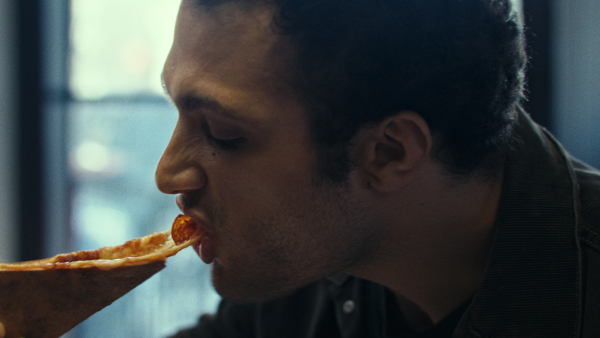
The two have their first misunderstanding over pizza, Saul rudely chuckling as Zama struggles to eat her slice while maintaining the integrity of her niqab. “It’s not funny!” she says, pissed. And it’s the first time in Saul’s life when he is forced to recognize difference with empathy, rather than apathy or disdain. He’s learning something real, tangible about her, as they scarf down the pizza (yes, from a place called Sal’s). They get deeper into their pasts over a Pakistani steam table meal on Coney Island Avenue. Saul sees men praying in a back room and Zama is shamed by a male diner who, rather than being upset with her for being in a place typically reserved for men, ultimately admits he simply misses his daughter who he is separated from. If not for the dahl in their bowls, we might not have had the chance to know this. To know anything.
And, of course, they fall in love over Russian pickles and Siberian butter. Two scenes that sadly didn’t make final cut had them arguing over Cantonese roast pork – a Jew and a Muslim walk into a Chinese restaurant – and rage-feasting over Uzbek-Uyghurian chicken tabaka. Food isn’t the only thing between them – there is music, Air Jordans, taking walks and a shared appetite for revenge, but it’s their actual hunger in which they truly recognize each other and the world they live in. They start as strangers from two of Brooklyn’s completely different worlds, but save each other over the simple nourishment of a meal. Breaking bread, chapati, roti, matzo, rye, naan is the actual soul of the story.

Since the start of the pandemic, I’ve heard so many people say New York is done. That it’s over. If you are one of those people, please just shut up. Not only does that ignore historical precedent, it is both naïve and stupid – and how can you say that when both the Knicks and Nets are good at the same time? Impossible! My wife and a lot of friends grew up in the city when it was broke. When it was truly dangerous, corner to corner. It changed. The World Trade Center crumbled to the ground and the city was devastated. It came back. Throughout the pandemic, the city has been cooped up, pent up, it has lost jobs, lost time, lost education, lost loved ones. But it’s not over. It will just change, evolve, as it always has. So what if Midtown is empty, maybe it’ll turn into something other than office space. Maybe it will become affordable housing. Additional public school space. A labyrinth (what the fuck do I know, I’m not an urban planner). But whatever it becomes, some will love the change, others will rail against it. That’s New York. It will always be a struggle. It will never be easy. It’s not New Jersey.
The other day, I took the subway out to Brighton Beach. It was one of those warm, sunny days – more of which are coming, day by day, as we head into spring in New York (still unbeatable!). I hit Brighton Bazaar on the corner of Coney Island Avenue, picked up a Russian steam table lunch with some pickles and headed to a bench on the boardwalk. I ate my lunch looking out at the ocean, which sparkled in the sun. The spring air felt so good. I lingered there for an extra long time. I could hear voices down by the water. A slight breeze pushed a cloud in the sky. In that moment was what I aimed to capture in Funny Face – a city filled with rage, with uncertainty, but also with love. I ate, and thought about the time ahead. The pickles were so sour. And delicious.



